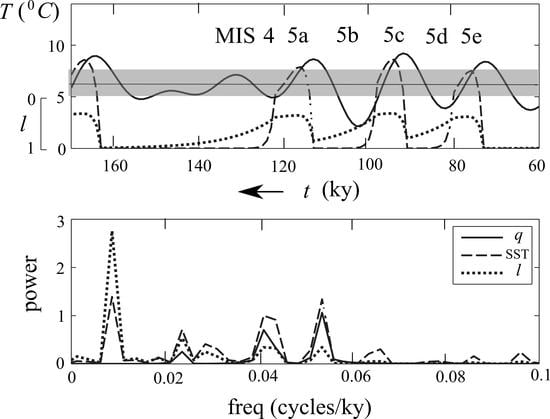A Theory of Orbital-Forced Glacial Cycles: Resolving Pleistocene Puzzles
Abstract
:1. Introduction
2. Coupled Climate Model
2.1. Regime Diagram
2.2. MEP States
3. Glacial Cycles
3.1. Orbital Forcing
3.2. Hysteresis
3.3. Ice Margin
3.4. Pleistocene Transitions
3.5. Timeseries
4. Resolving Pleistocene Glacial Puzzles
- 41-ky problem: since the ocean is forced by the absorbed SW flux, the absence of ice–albedo feedback in the relatively warm early Pleistocene naturally filters out the precession forcing on account of the Kepler’s second law. On the other hand, since the sea-level snowline remains landward of the Arctic Ocean because of the perennial ice, there is always a (continental) polar cap to facilitate the 41-ky obliquity signal [43];
- 100-ky problem: the active ice–albedo feedback in late Pleistocene has nullified Kepler’s second law in instituting the precession forcing modulated by eccentricity. Because of the atmospheric coupling, an eddying ocean is bistable, which translates to bistable ice states of polar cap and LIS. The latter, however, is attained only during low eccentricity when precession peaks no longer clear the warm threshold, thus allowing a prolonged coldness that defines the ice age. This results in 100-ky ice-age cycles paced by eccentricity [95,96];
- MPT problem: the bistable interval is set by the global convective flux, which is lowered during Pleistocene cooling on account of the surface heat balance. Combined with increasing ice–albedo feedback, it segregates the 41- and 100-ky cycles to early and late Pleistocene, respectively, resulting in their mid-Pleistocene transition. Differing from previous conjectures, however, our model has produced specific markers of the MPT (Equations (16) and (17)), which are broadly in accord with the observed timings [23];
- 400-ky problem: so long as the ice-age is already paced by eccentricity of the shorter 100-ky period, the amplitude of the ice-age cycles would be set by the bistable ice states hence unaffected by the longer-period 400-ky eccentricity even though it has comparable amplitude as the shorter one [89];
- Stage-11 problem: despite bistable ice states, a smaller eccentricity would lengthen the ice age to augment the ice signal, thus resolving the Stage-11 problem [89]. By the same token, the time-varying power of the 100-ky eccentricity would anti-correlate with that of the ice-age cycle, as noted by [97], which thus need not involve unknown climate feedback;
- Variable termination problem: Since onset and termination of the ice age are threshold phenomena, both can be off by one precession period depending on the precise timing, the ice-age cycles thus may vary between 80- and 120-ky [98];
- Polar synchronization problem: with Antarctica iced over since late Miocene, it exerts no ice–albedo feedback in instituting the precession forcing—irrespective of its seasonal insolation being anti-phase with its northern counterpart [99]. Then with the glacial cycles dominated by the northern ice sheet, it would feedback into the global balance [88] to synchronize the Antarctic climate, as suggested by its slight lag [96].
5. Discussion
Funding
Data Availability Statement
Acknowledgments
Conflicts of Interest
Abbreviations
| DNS | Direct numerical simulation |
| EL | Equilibrium line |
| ELA | Equilibrium-line altitude |
| EPT | Early Pleistocene transition |
| FT | Fluctuation theorem |
| G/IG | Glacial/interglacial |
| IRD | Ice-rafted debris |
| LGM | Last glacial maximum |
| LIS | Laurentide ice sheet |
| LW | Long-wave |
| Ma | Million years ago |
| MEP | Maximum entropy production |
| MI | Milankovitch insolation |
| MIS | Marine isotope stage |
| MOC | Meridional overturning circulation |
| MPT | Mid-Pleistocene transition |
| NADW | North Atlantic Deep Water |
| NT | Nonequilibrium thermodynamics |
| PDD | Positive degree-day |
| SAT | Surface-air temperature |
| SST | Sea-surface temperature |
| SW | Short-wave |
Appendix A
| Global ice cover | |
| Ablation | |
| Accumulation | |
| Forcing amplitudes | |
| Bo | Ratio of sensible to latent heat transports |
| c | Ice dynamics parameter ( |
| Specific heat of water | |
| Saturation vapor pressure | |
| Atmospheric energy transport | |
| Gravitational acceleration () | |
| h | Ice height |
| ELA | |
| K | MOC strength |
| [K] | Scale of K () |
| x-coordinate of EL | |
| , | x-coordinate of ice margin |
| Equilibrium l | |
| Latent heat of sublimation () | |
| Melt rate () | |
| Exponent of admittance power law | |
| Global absorbed SW flux | |
| Cold-box deficit of absorbed SW flux | |
| Dimensional | |
| Cold-box deficit of convective flux | |
| Time-mean of () | |
| Amplitude of () | |
| Scale of ( | |
| Global convective flux | |
| Global surface LW flux | |
| Cold-transition threshold | |
| Warm-transition threshold | |
| Cold-box salinity deficit | |
| Scale of = 1.79) | |
| Entropy production rate | |
| Sv | Sverdrup () |
| Global SST (=14 °C) | |
| Cold-box SST deficit | |
| Dimensional | |
| Scale of | |
| Equilibrium | |
| Freezing-point | |
| w | Half continental width |
| Thermal expansion coefficient ( | |
| Air-sea transfer coefficient (, [21]) | |
| Saline contraction coefficient ( | |
| Lapse rate | |
| Fluctuation amplitude | |
| Cold-box density surplus | |
| Scale of ( | |
| Ice density () | |
| Water density () | |
| Yield stress () | |
| Ice time constant for retreat/advance) | |
| Temperature time constant | |
| Melt rate per degree temperature (=0.8 my−1 °C−1) | |
| Moisture parameter | |
| Dimensionless moisture parameter (0.3, [21]) | |
| Diapycnal diffusivity |
References
- Hays, J.D.; Imbrie, J.; Shackleton, N.J. Variations in the Earth’s orbit: Pacemaker of the ice ages. Science 1976, 194, 1121–1132. [Google Scholar] [CrossRef]
- Berger, A. Spectrum of climatic variations and their causal mechanisms. Geophys. Surv. 1979, 3, 351–402. [Google Scholar] [CrossRef]
- Milankovitch, M. Canon of Insolation and the Ice-Age Problem; R Serb Acad Spec 1941, Publ 132 (Translated from German); Israel Program for Scientific Translations: Jerusalem, Israel, 1969. [Google Scholar]
- Donohoe, A.; Battisti, D.S. The seasonal cycle of atmospheric heating and temperature. J. Clim. 2013, 26, 4962–4980. [Google Scholar] [CrossRef]
- Peixoto, J.P.; Oort, A.H. Physics of Climate; American Institute of Physics: New York, NY, USA, 1992. [Google Scholar] [CrossRef]
- Dansgaard, W.; Johnsen, S.; Clausen, H.B.; Dahl-Jensen, D.; Gundestrup, N.; Hammer, C.U.; Hvldberg, C.S.; Steffensen, J.P.; Sveinbjornsdottir, A.E.; Jouzel, J.; et al. Evidence for general instability of past climate from a 250-kyr ice-core record. Nature 1993, 364, 218–220. [Google Scholar] [CrossRef]
- Labeyrie, L.; Vidal, L.; Cortijo, E.; Paterne, M.; Arnold, M.; Duplessy, J.C.; Vautravers, M.; Labracherie, M.; Dupart, J.; Turon, J.L.; et al. Surface and deep hydrology of the Northern Atlantic Ocean during the last 150,000 years. Philos. Trans. R. Soc. Lond. Ser. B 1995, 348, 255–264. [Google Scholar] [CrossRef]
- Chapman, M.R.; Shackleton, N.J. Global ice-volume fluctuations, North Atlantic ice-rafting events, and deep-ocean circulation changes between 130 and 70 ka. Geology 1999, 27, 795–798. [Google Scholar] [CrossRef]
- Petit, J.R.; Jouzel, J.; Raynaud, D.; Barkov, N.I.; Barnola, J.M.; Basile, I.; Bender, M.; Chappellaz, J.; Davis, M.; Delaygue, G.; et al. Climate and atmospheric history of the past 420,000 years from the Vostok ice core, Antarctica. Nature 1999, 399, 429–436. [Google Scholar] [CrossRef]
- Shackleton, N. The 100,000-year ice-age cycle identified and found to lag temperature, carbon dioxide, and orbital eccentricity. Science 2000, 289, 1897–1902. [Google Scholar] [CrossRef]
- Broecker, W.S.; Denton, G.H. The role of ocean-atmosphere reorganization in glacial cycles. Geochim. Cosmochim. Acta 1989, 53, 2465–2501. [Google Scholar] [CrossRef]
- Birchfield, G.E.; Weertman, J.; Lunde, A.T. A paleoclimate model of Northern Hemisphere ice sheets. Quat. Res. 1981, 15, 126–142. [Google Scholar] [CrossRef]
- Gallée, H.; Van Yperselb, J.P.; Fichefet, T.; Marsiat, I.; Tricot, C.; Berger, A. Simulation of the last glacial cycle by a coupled, sectorially averaged climate-ice sheet model: 2. Response to insolation and CO2 variations. J. Geophys. Res. 1992, 97, 15713–15740. [Google Scholar] [CrossRef]
- Berger, A.; Li, X.; Loutre, M. Modeling northern hemisphere ice volume over the last 3 ma. Quat. Sci. Rev. 1999, 18, 1–11. [Google Scholar] [CrossRef]
- Abe-Ouchi, A.; Segawa, T.; Saito, F. Climatic conditions for modelling the Northern Hemisphere ice sheets throughout the ice age cycle. Clim. Past 2007, 3, 423–438. [Google Scholar] [CrossRef]
- Auer, S.J. Five-year climatological survey of the Gulf Stream system and its associated rings. J. Geophys. Res. 1987, 92, 11709–11726. [Google Scholar] [CrossRef]
- Lozier, M.S. Deconstructing the conveyer belt. Science 2010, 328, 1507–1511. [Google Scholar] [CrossRef]
- Dalan, F.; Stone, P.; Kamenkovich, I.V.; Scott, J.R. Sensitivity of the Ocean’s Climate to Diapycnal Diffusivity in an EMIC. Part I: Equilibrium State. J. Clim. 2005, 18, 2460–2481. [Google Scholar] [CrossRef]
- Rahmstorf, S.; Crucifix, M.; Ganopolski, A.; Goosse, M.; Kamenkovich, I.; Knutti, R.; Lohmann, G.; Marsh, R.; Mysak, L.A.; Wang, Z.; et al. Thermohaline circulation hysteresis: A model intercomparison. Geophys. Res. Lett. 2005, 32, L23605. [Google Scholar] [CrossRef]
- Ganopolski, A.; Brovkin, V. Simulation of climate, ice sheets and CO2 evolution during the last four glacial cycles with an Earth system model of intermediate complexity. Clim. Past 2017, 13, 1695–1716. [Google Scholar] [CrossRef]
- Ou, H.W. Thermohaline circulation: A missing equation and its climate change implications. Clim. Dyn. 2018, 50, 641–653. [Google Scholar] [CrossRef]
- Elkibbi, M.; Rial, J.A. An outsider’s review of the astronomical theory of the climate: Is the eccentricity-driven insolation the main driver of the ice ages? Earth Sci. Rev. 2001, 56, 161–177. [Google Scholar] [CrossRef]
- Clark, P.U.; Archer, D.; Pollard, D.; Blum, J.D.; Rial, J.A.; Brovkin, V.; Mix, A.C.; Pisias, N.G.; Roy, M. The middle Pleistocene transition: Characteristics, mechanisms, and implications for long-term changes in atmospheric pCO2. Quat. Sci. Rev. 2006, 25, 3150–3184. [Google Scholar] [CrossRef]
- Imbrie, J.; Imbrie, J.Z. Modeling the Climatic Response to Orbital Variations. Science 1980, 207, 943–953. [Google Scholar] [CrossRef] [PubMed]
- Oerlemans, J. Glacial cycles and ice-sheet modelling. Clim. Change 1982, 4, 353–374. [Google Scholar] [CrossRef]
- Pollard, D. A coupled climate-ice sheet model applied to the Quaternary ice ages. J. Geophys. Res. 1983, 88, 7705–7718. [Google Scholar] [CrossRef]
- Pelletier, J.D. Coherence resonance and ice ages. J. Geophys. Res. 2003, 108, 4645. [Google Scholar] [CrossRef]
- Ghil, M. Cryothermodynamics: The chaotic dynamics of paleoclimate. Phys. D Nonlinear Phenom. 1994, 77, 130–159. [Google Scholar] [CrossRef]
- Wunsch, C. The spectral description of climate change including the 100 ky energy. Clim. Dyn. 2003, 20, 353–363. [Google Scholar] [CrossRef]
- Tziperman, E.; Raymo, M.E.; Huybers, P.J.; Wunsch, C. Consequences of pacing the Pleistocene 100 kyr ice ages by nonlinear phase locking to Milankovitch forcing. Paleoceanography 2006, 21, 1–11. [Google Scholar] [CrossRef]
- Ravelo, A.N.; Andreasen, D.H.; Lyle, M.; Lyle, A.O.; Wara, M.W. Regional climate shifts caused by gradual global cooling in the Pliocene epoch. Nature 2004, 429, 263–267. [Google Scholar] [CrossRef]
- Saltzman, B.; Hansen, A.; Maasch, K. The late Quaternary glaciations as the response of a three-component feedback system to Earth-orbital forcing. J. Atmos. Sci. 1984, 41, 3380–3389. [Google Scholar] [CrossRef]
- Paillard, D. The timing of Pleistocene glaciations from a simple multiple-state climate model. Nature 1998, 391, 378–381. [Google Scholar] [CrossRef]
- Imbrie, J.Z.; Imbrie-Moore, A.; Lisiecki, L.E. A phase-space model for Pleistocene ice volume. Earth Planet. Sci. Lett. 2011, 307, 94–102. [Google Scholar] [CrossRef]
- Crucifix, M. Why could ice ages be unpredictable? Clim. Past 2013, 9, 2253–2267. [Google Scholar] [CrossRef]
- Daruka, I.; Ditlevsen, P.D. A conceptual model for glacial cycles and the middle Pleistocene transition. Clim. Dyn. 2016, 46, 29–40. [Google Scholar] [CrossRef]
- Verbitsky, M.Y.; Crucifix, M.; Volobuev, D.M. A theory of Pleistocene glacial rhythmicity. Earth Syst. Dyn. 2018, 9, 1025–1043. [Google Scholar] [CrossRef]
- Willeit, M.; Ganopolski, A.; Calov, R.; Brovkin, V. Mid-Pleistocene transition in glacial cycles explained by declining CO2 and regolith removal. Sci. Adv. 2019, 5, eaav7337. [Google Scholar] [CrossRef]
- Honisch, B.; Hemming, N.G.; Archer, D.; Siddall, M.; McManus, J.F. Atmospheric carbon dioxide concentration across the mid-Pleistocene transition. Science 2009, 324, 1551–1554. [Google Scholar] [CrossRef] [PubMed]
- Weertman, J. Milankovitch solar radiation variations and ice age ice sheet sizes. Nature 1976, 261, 17–20. [Google Scholar] [CrossRef]
- Calov, R.; Ganopolski, A. Multistability and hysteresis in the climate-cryosphere system under orbital forcing. Geophys. Res. Lett. 2005, 32, L21717. [Google Scholar] [CrossRef]
- Berger, A.; Loutre, M.F. Modeling the 100-kyr glacial–interglacial cycles. Glob. Planet. Change 2010, 72, 275–281. [Google Scholar] [CrossRef]
- Raymo, M.E.; Nisancioglu, K.H. The 41 kyr world: Milankovitch’s other unsolved mystery. Paleoceanography 2003, 18. [Google Scholar] [CrossRef]
- Kucera, M.; Weinelt, M.; Kiefer, T.; Pflaumann, U.; Hayes, A.; Weinelt, M.; Chen, M.T.; Mix, A.C.; Barrows, T.T.; Cortijo, E.; et al. Reconstruction of sea-surface temperatures from assemblages of planktonic foraminifera: Multi-technique approach based on geographically constrained calibration data sets and its application to glacial Atlantic and Pacific Oceans. Quat. Sci. Rev. 2005, 24, 951–998. [Google Scholar] [CrossRef]
- Stommel, H. Thermohaline convection with two stable regimes of flow. Tellus 1961, 13, 224–230. [Google Scholar] [CrossRef]
- Marotzke, J.; Stone, P. Atmospheric transports, the thermohaline circulation, and flux adjustments in a simple coupled model. J. Phys. Oceanogr. 1995, 25, 1350–1364. [Google Scholar] [CrossRef]
- Manabe, S.; Stouffer, R.J. Two stable equilibria of a coupled ocean-atmosphere model. J. Clim. 1988, 1, 841–866. [Google Scholar] [CrossRef]
- Crooks, G.E. Entropy production fluctuation theorem and the nonequilibrium work relation for free energy differences. Phys. Rev. 1999, 60, 2721–2726. [Google Scholar] [CrossRef]
- Ou, H.W. Possible bounds on the earth’s surface temperature: From the perspective of a conceptual global-mean model. J. Clim. 2001, 14, 2976–2988. [Google Scholar] [CrossRef]
- Ozawa, H.; Ohmura, A.; Lorenz, R.D.; Pujol, T. The second law of thermodynamics and the global climate system: A review of the maximum entropy production principle. Rev. Geophys. 2003, 41, 1018. [Google Scholar] [CrossRef]
- Kleidon, A. Non-equilibrium thermodynamics and maximum entropy production in the Earth system: Applications and implications. Naturwissenschaften 2009, 96, 653–677. [Google Scholar] [CrossRef]
- Evans, D.J.; Searle, D.J. The fluctuation theorem. Adv. Phys. 2002, 51, 1529. [Google Scholar] [CrossRef]
- Wang, G.M.; Sevick, E.M.; Mittag, E.; Searles, D.J.; Evans, D.J. Experimental demonstration of violations of the Second Law of Thermodynamics for small systems and short time scales. Phys. Rev. Lett. 2002, 89, 050601. [Google Scholar] [CrossRef] [PubMed]
- Hogg, A.M.; Gayen, B. Ocean gyres driven by surface buoyancy forcing. Geophys. Res. Lett. 2020, 47, e2020GL088539. [Google Scholar] [CrossRef]
- Colin de Verdière, A. Buoyancy driven planetary flows. J. Mar. Res. 1988, 46, 2215–2265. [Google Scholar] [CrossRef]
- Ou, H.W. Meridional thermal field of a coupled ocean-atmosphere system: A conceptual model. Tellus A Dyn. Meteorol. Oceanogr. 2006, 58, 404–415. [Google Scholar] [CrossRef]
- Ou, H.W. A theory of abrupt climate changes: Their genesis and anatomy. Geosciences 2022, 12, 391. [Google Scholar] [CrossRef]
- Macdonald, A.M. The global ocean circulation: A hydrographic estimate and regional analysis. Prog. Oceanogr. 1998, 41, 281–382. [Google Scholar] [CrossRef]
- De Vernal, A.; Eynaud, F.; Henry, M.; Hillaire-Marcel, C.; Londeix, L.; Mangin, S.; Matthiessen, J.; Marret, F.; Radi, T.; Rochon, A.; et al. Reconstruction of sea surface conditions at middle to high latitudes of the Northern Hemisphere during the Last Glacial Maximum (LGM) based on dinoflagellate cyst assemblages. Quat. Sci. Rev. 2005, 24, 897–924. [Google Scholar] [CrossRef]
- Gildor, H.; Tziperman, E. Sea ice as the glacial cycles climate switch: Role of seasonal and orbital forcing. Paleoceanography 2000, 15, 605–615. [Google Scholar] [CrossRef]
- Duplessy, J.C.; Shackleton, N.J. Response of global deep-water circulation to Earth’s climatic change 135,000–107,000 years ago. Nature 1985, 316, 500–507. [Google Scholar] [CrossRef]
- Keigwin, L.D.; Curry, W.B.; Lehman, S.J.; Johnsen, S. The role of the deep ocean in North Atlantic climate change between 70 and 130 kyr ago. Nature 1994, 371, 323–326. [Google Scholar] [CrossRef]
- Berger, A.; Loutre, M.F.; Kaspar, F.; Lorenz, S.J. Chapter 2—Insolation during interglacial. In Developments in Quaternary Sciences; Elsevier: Amsterdam, The Netherlands, 2007; Volume 7, pp. 13–27. [Google Scholar] [CrossRef]
- Berger, A. Milankovitch theory and climate. Rev. Geophys. 1988, 26, 624–657. [Google Scholar] [CrossRef]
- Short, D.A.; Mengel, J.G.; Crowley, T.J.; Hyde, W.T.; North, G.R. Filtering of Milankovitch cycles by Earth’s geography. Quat. Res. 1991, 35, 157–173. [Google Scholar] [CrossRef]
- Huybers, P. Early Pleistocene glacial cycles and the integrated summer insolation forcing. Science 2006, 313, 508–511. [Google Scholar] [CrossRef] [PubMed]
- Pollard, D. A simple parameterization for ice sheet ablation rate. Tellus 1980, 32, 384–388. [Google Scholar] [CrossRef]
- Peltier, W.R. Ice age paleotopography. Science 1994, 265, 195–201. [Google Scholar] [CrossRef] [PubMed]
- Berger, A.; Gallee, H.; Li, X.S.; Dutrieux, A.; Loutre, M.F. Ice sheet growth and high-latitudes sea surface temperature. Clim. Dyn. 1996, 12, 441–448. [Google Scholar] [CrossRef]
- Abe-Ouchi, A.; Saito, F.; Kawamura, K.; Raymo, M.E.; Okuno, J.I.; Takahashi, K.; Blatter, H. Insolation-driven 100,000-year glacial cycles and hysteresis of ice-sheet volume. Nature 2013, 500, 190–193. [Google Scholar] [CrossRef]
- Van der Veen, C.I. Fundamentals of Glacier Dynamics, 2nd ed.; CRC Press: Boca Raton, FL, USA, 2013; p. 403. [Google Scholar] [CrossRef]
- Reeh, N. A plasticity theory approach to the steady-state shape of a three-dimensional ice sheet. J. Glaciol. 1982, 28, 431–455. [Google Scholar] [CrossRef]
- Robin, G.D. Ice cores and climatic change. Philos. Trans. R. Soc. Lond. Ser. B 1977, 280, 143–168. [Google Scholar] [CrossRef]
- Ou, H.W. Hydrological cycle and ocean stratification in a coupled climate system: A theoretical study. Tellus 2007, 59, 683–694. [Google Scholar] [CrossRef]
- Ohmura, A.; Reeh, N. New precipitation and accumulation maps for Greenland. J. Glaciol. 1991, 37, 140–148. [Google Scholar] [CrossRef]
- Bromwich, D.H.; Robasky, F.M.; Keen, R.A.; Bolzan, J.F. Modeled variations of precipitation over the Greenland ice sheet. J. Clim. 1993, 6, 1253–1268. [Google Scholar] [CrossRef]
- Alley, R.B.; Meese, D.A.; Shuman, C.A.; Glow, A.J.; Taylor, K.C.; Grouts, P.M.; White, J.W.C.; Ram, M.; Waddington, E.D.; Mayewski, P.A.; et al. Abrupt increase in snow accumulation at the end of the Younger Dryas event. Nature 1993, 362, 527–529. [Google Scholar] [CrossRef]
- Reeh, N. Parameterization of melt rate and surface temperature in the Greenland ice sheet. Polarforschung 1991, 59, 113–128. [Google Scholar]
- Oerlemans, J. The mass balance of the Greenland ice sheet: Sensitivity to climate change as revealed by energy-balance modelling. Holocene 1991, 1, 40–48. [Google Scholar] [CrossRef]
- North, G.R.; Mengel, J.G.; Short, D.A. Simple energy balance model resolving the seasons and the continents: Application to the astronomical theory of the ice ages. J. Geophys. Res. 1983, 88, 6576–6586. [Google Scholar] [CrossRef]
- Carlson, A. Why there was not a Younger Dryas-like event during the Penultimate Deglaciation? Quat. Sci. Rev. 2008, 27, 882–887. [Google Scholar] [CrossRef]
- Oerlemans, J. Model experiments on the 100,000-yr glacial cycle. Nature 1980, 287, 430–432. [Google Scholar] [CrossRef]
- Clark, D.L. Origin, nature and world climate effect of Arctic Ocean ice-cover. Nature 1982, 300, 321–325. [Google Scholar] [CrossRef]
- Ruddiman, W.; Raymo, M. Northern Hemisphere climate regimes during the past 3 Ma: Possible tectonic connections. Philos. Trans. R. Soc. Lond. Ser. B 1988, 318, 411–430. [Google Scholar] [CrossRef]
- Raymo, M.E.; Ruddiman, W.F. Tectonic forcing of late Cenozoic climate. Nature 1992, 1359, 117–122. [Google Scholar] [CrossRef]
- Previdi, M. Radiative feedbacks on global precipitation. Environ. Res. Lett. 2010, 5, 025211. [Google Scholar] [CrossRef]
- Martínez-Botí, M.A.; Foster, G.L.; Chalk, T.B.; Rohling, E.J.; Sexton, P.F.; Lunt, D.J.; Pancost, R.D.; Badger, M.P.; Schmidt, D.N. Plio-Pleistocene climate sensitivity evaluated using high-resolution CO2 records. Nature 2015, 518, 49–54. [Google Scholar] [CrossRef] [PubMed]
- Broccoli, A.J.; Manabe, S. The influence of continental ice, atmospheric CO2, and land albedo on the climate of the last glacial maximum. Clim. Dyn. 1987, 1, 87–99. [Google Scholar] [CrossRef]
- Imbrie, J.; Berger, A.; Boyle, E.; Clemens, S.C.; Duffy, A.; Howard, W.R.; Kukla, G.; Kutzbach, J.; Martinson, D.G.; McIntyre, A.; et al. On the structure and origin of major glaciation cycles 2. The 100,000-year cycle. Paleoceanography 1993, 8, 699–735. [Google Scholar] [CrossRef]
- Lisiecki, L.E.; Raymo, M.E. Plio–Pleistocene climate evolution: Trends and transitions in glacial cycle dynamics. Quat. Sci. Rev. 2007, 26, 56–69. [Google Scholar] [CrossRef]
- Lisiecki, L.E.; Raymo, M.E. A Pliocene-Pleistocene stack of 57 globally distributed benthic δ18O records. Paleoceanography 2005, 20, PA1003. [Google Scholar] [CrossRef]
- Ruddiman, W.F.; McIntyre, A. The North Atlantic Ocean during the last deglaciation. Palaeogeogr. Palaeoclimatol. Palaeoecol. 1981, 35, 145–214. [Google Scholar] [CrossRef]
- McManus, J.F.; Bond, G.C.; Broecker, W.S.; Johnsen, S.; Labeyrie, L.; Higgins, S. High-resolution climate records from the N. Atlantic during the last interglacial. Nature 1994, 371, 326–329. [Google Scholar] [CrossRef]
- Ruddiman, W.F.; McIntyre, A.; Niebler-Hunt, V.; Durazzi, J.T. Oceanic evidence for the mechanism of rapid northern hemisphere glaciation. Quat. Res. 1980, 13, 33–64. [Google Scholar] [CrossRef]
- Raymo, M.E. The timing of major climate terminations. Paleoceanography 1997, 12, 577–585. [Google Scholar] [CrossRef]
- Kawamura, K.; Parrenin, F.; Lisiecki, L.; Uemura, R.; Vimeux, F.; Severinghaus, J.P.; Hutterli, M.A.; Nakazawa, T.; Aoki, S.; Jouzel, J.; et al. Northern Hemisphere forcing of climatic cycles in Antarctica over the past 360,000 years. Nature 2007, 448, 912–916. [Google Scholar] [CrossRef]
- Lisiecki, L.E. Links between eccentricity forcing and the 100,000-year glacial cycle. Nat. Geosci. 2010, 3, 349–352. [Google Scholar] [CrossRef]
- Raymo, M.E.; Oppo, D.W.; Curry, W. The mid-Pleistocene climate transition: A deep sea carbon isotopic perspective. Paleoceanography 1997, 12, 546–559. [Google Scholar] [CrossRef]
- Clark, P.U.; Alley, R.B.; Pollard, D. Northern Hemisphere ice sheet influences on global climate change. Science 1999, 286, 1104–1111. [Google Scholar] [CrossRef]
- Kleidon, A.; Fraedrich, K.; Kunz, T.; Lunkeit, F. The atmospheric circulation and states of maximum entropy production. Geophys. Res. Lett. 2003, 30. [Google Scholar] [CrossRef]
- Kunz, T.; Fraedrich, K.; Kirk, E. Optimisation of simplified GCMs using circulation indices and maximum entropy production. Clim. Dyn. 2008, 30, 803–813. [Google Scholar] [CrossRef]
- Jupp, T.E.; Cox, P.M. MEP and planetary climates: Insights from a two-box climate model containing atmospheric dynamics. Philos. Trans. R. Soc. Lond. Ser. B 2010, 365, 1355–1365. [Google Scholar] [CrossRef] [PubMed]
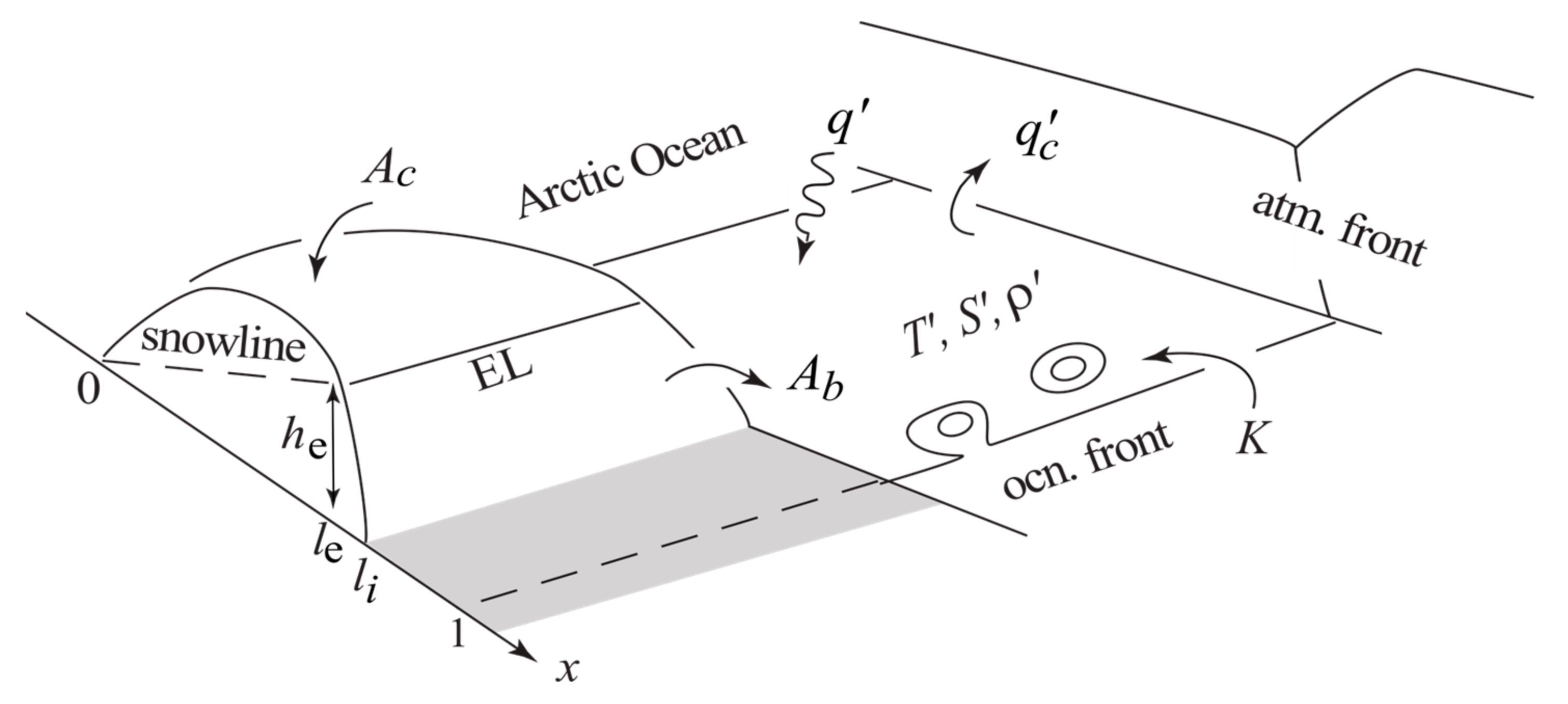

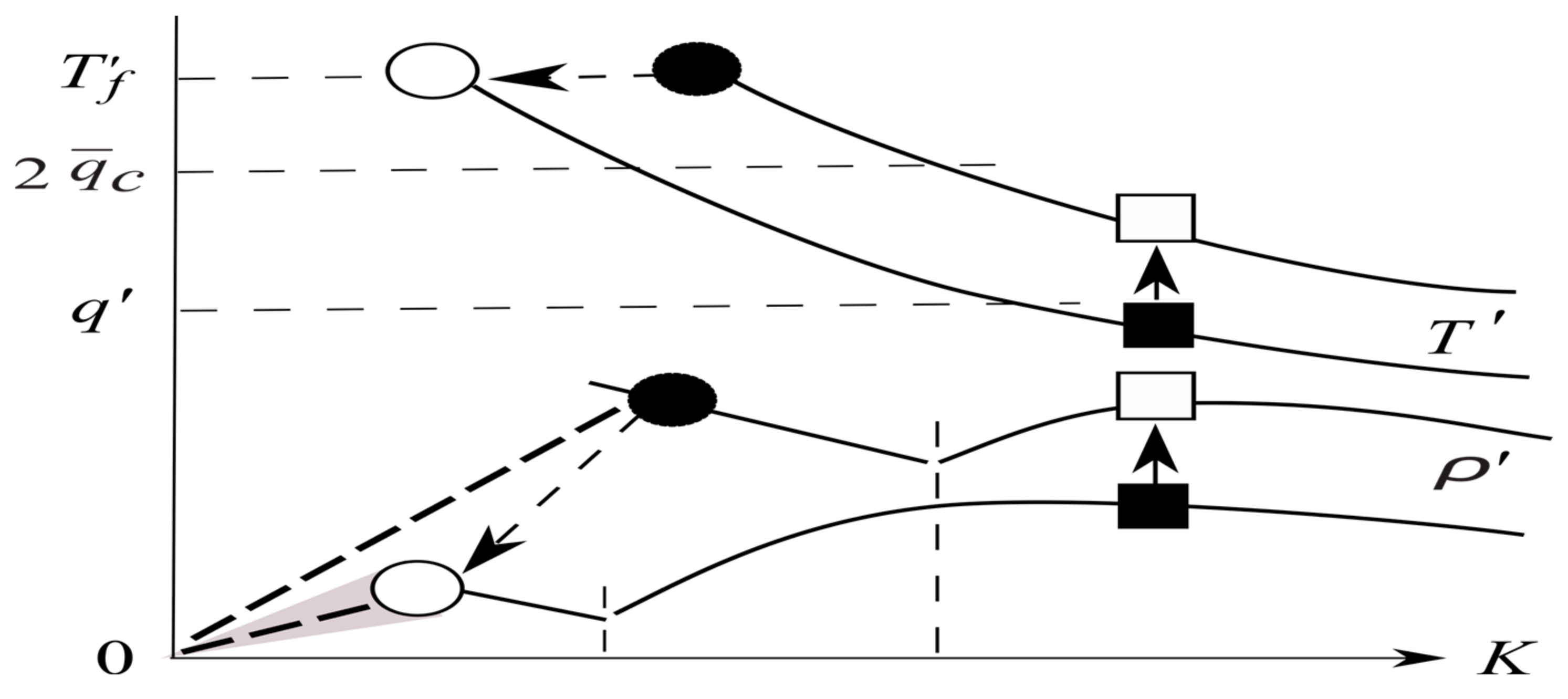
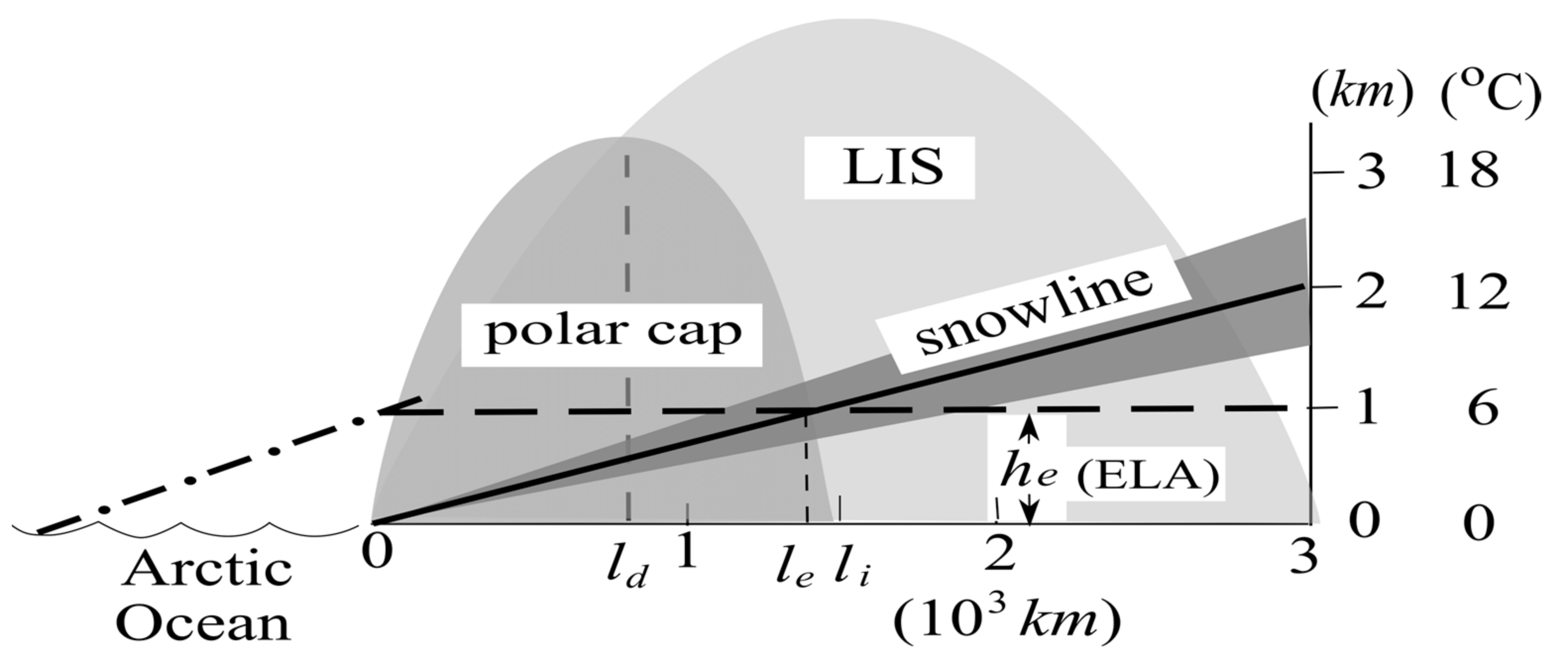
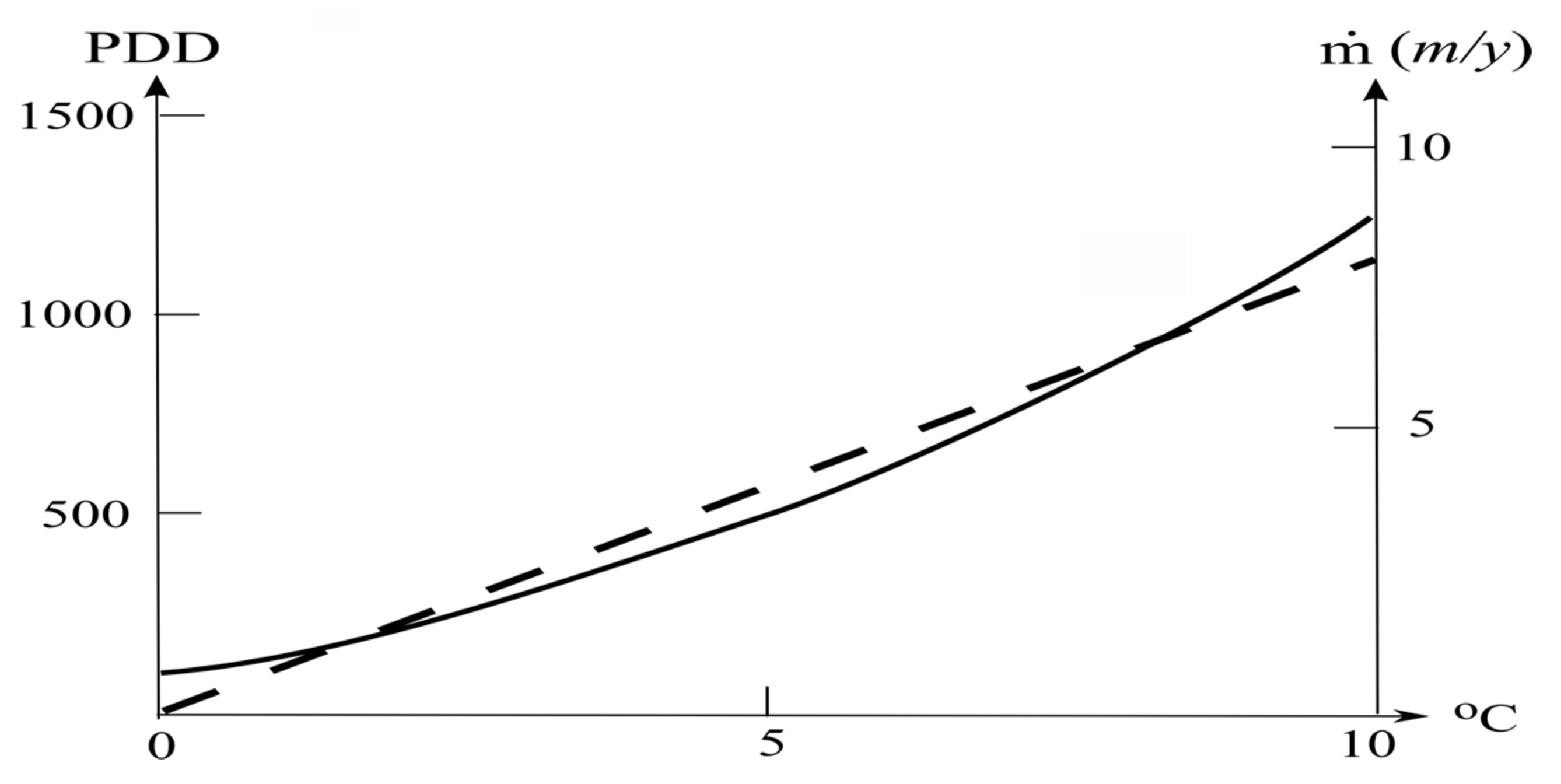
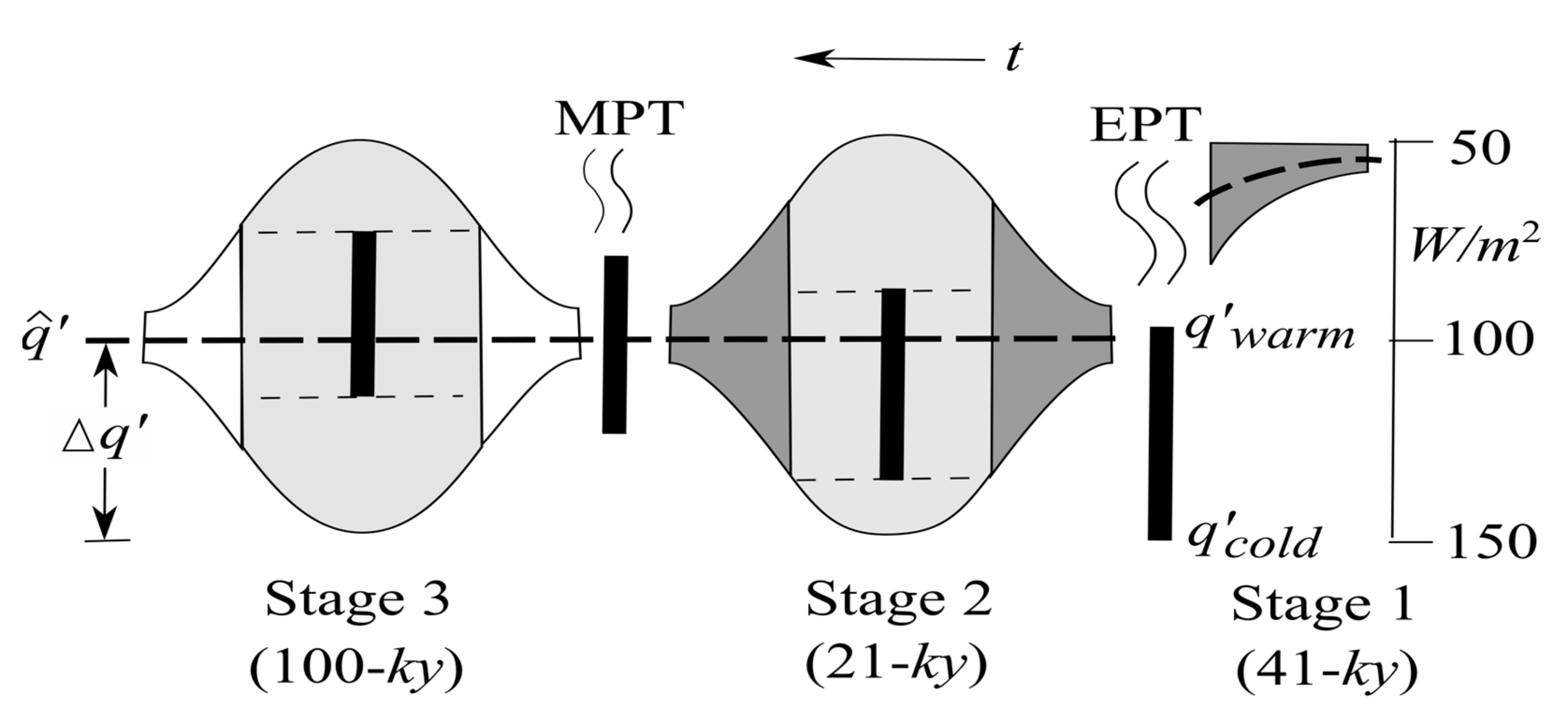
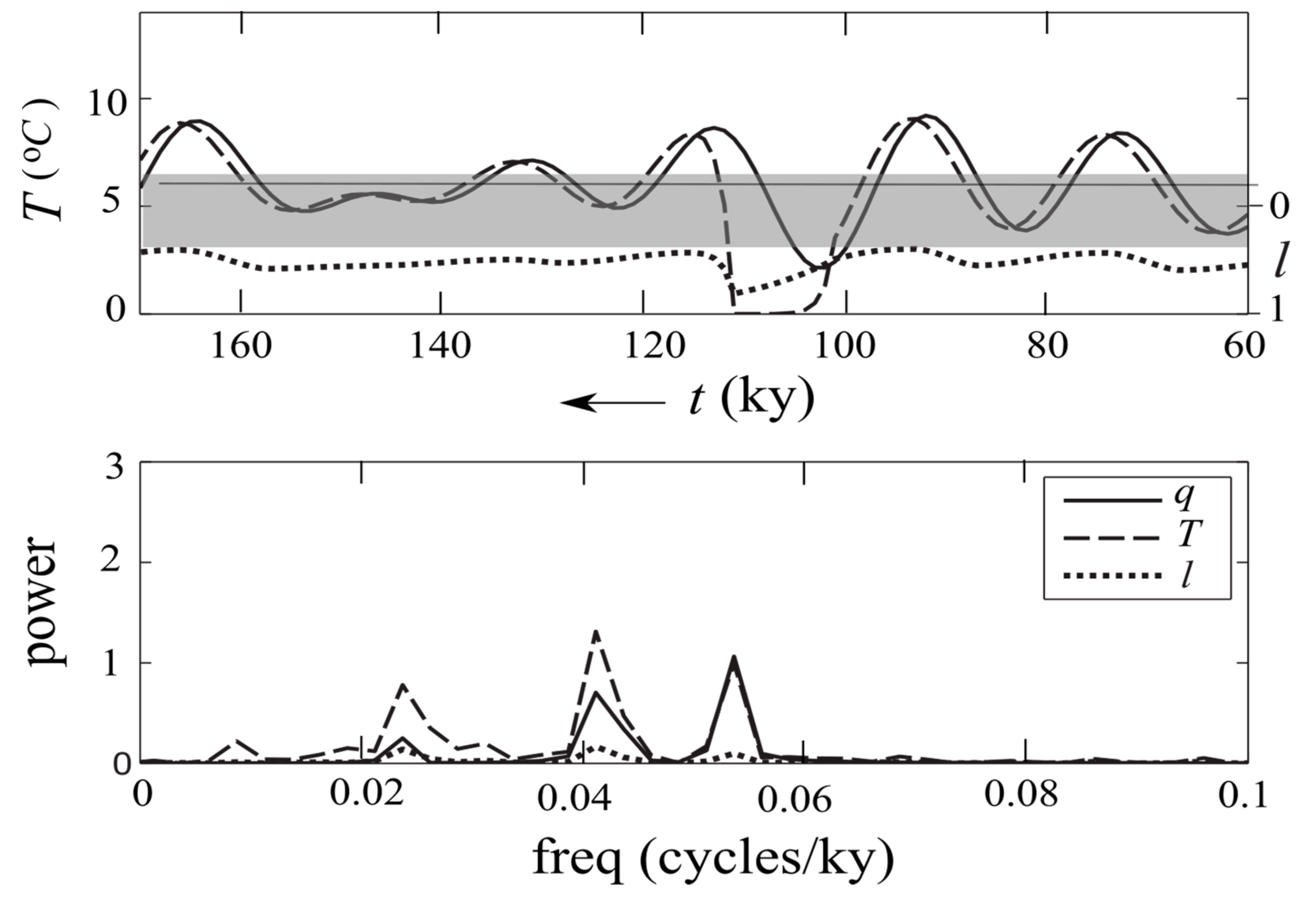

Disclaimer/Publisher’s Note: The statements, opinions and data contained in all publications are solely those of the individual author(s) and contributor(s) and not of MDPI and/or the editor(s). MDPI and/or the editor(s) disclaim responsibility for any injury to people or property resulting from any ideas, methods, instructions or products referred to in the content. |
© 2023 by the author. Licensee MDPI, Basel, Switzerland. This article is an open access article distributed under the terms and conditions of the Creative Commons Attribution (CC BY) license (https://creativecommons.org/licenses/by/4.0/).
Share and Cite
Ou, H.-W. A Theory of Orbital-Forced Glacial Cycles: Resolving Pleistocene Puzzles. J. Mar. Sci. Eng. 2023, 11, 564. https://doi.org/10.3390/jmse11030564
Ou H-W. A Theory of Orbital-Forced Glacial Cycles: Resolving Pleistocene Puzzles. Journal of Marine Science and Engineering. 2023; 11(3):564. https://doi.org/10.3390/jmse11030564
Chicago/Turabian StyleOu, Hsien-Wang. 2023. "A Theory of Orbital-Forced Glacial Cycles: Resolving Pleistocene Puzzles" Journal of Marine Science and Engineering 11, no. 3: 564. https://doi.org/10.3390/jmse11030564
APA StyleOu, H.-W. (2023). A Theory of Orbital-Forced Glacial Cycles: Resolving Pleistocene Puzzles. Journal of Marine Science and Engineering, 11(3), 564. https://doi.org/10.3390/jmse11030564





